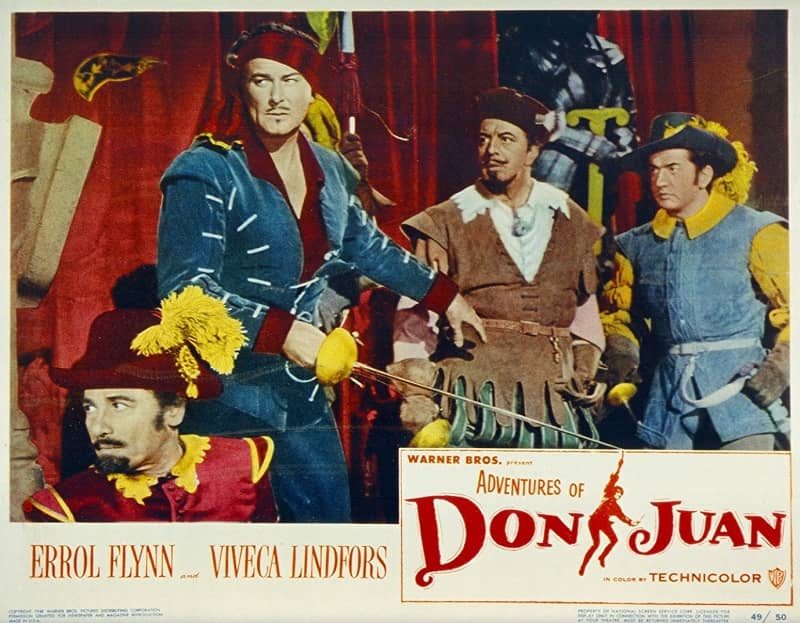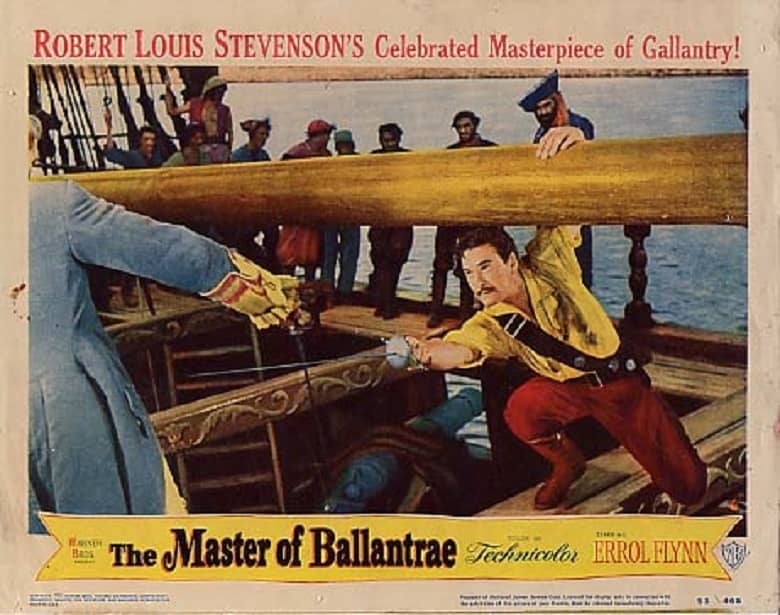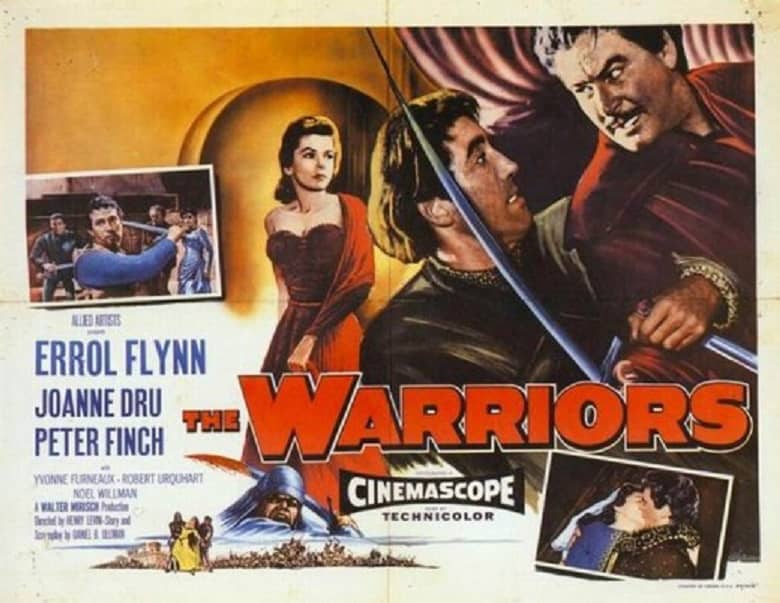Ellsworth’s Cinema of Swords: Flynn’s Last Flourishes
The Adventures of Don Juan (Warner Bros, 1948)
Errol Flynn’s late-career swashbucklers are widely considered mediocre efforts, desperate attempts by an aging and fading star to recapture his youthful popularity, but that sells the films short. It’s true that by the late Forties, Flynn could no longer match the vigor and charm of his performances in Captain Blood (1935), The Adventures of Robin Hood (1938), and The Sea Hawk (1940) … but really, who could? Compared to any other standard, Flynn’s later sword-slingers are average at worst and mostly better than that. Flynn wasn’t keen to make most of these pictures; he was well aware that he wasn’t the athletic rascal he’d been almost twenty years before, but he was still a solid leading man and now and then the old charm shone through. Enjoy these films for what they have to offer, and you won’t be sorry.
The Adventures of Don Juan
Rating: ***
Origin: USA, 1948
Director: Vincent Sherman
Source: Warner Bros. DVD
Errol Flynn had given up doing swashbucklers after The Sea Hawk (1940), but with the revival of the historical adventure genre in the late ‘40s, Warner Bros. gave him a sword and put him back in trunk-hose for The Adventures of Don Juan. It must be said, Flynn doesn’t seem entirely comfortable in the role of Don Juan de Maraña, the scandal-plagued womanizing rogue who is forced to give up his naughty ways and turn over a new leaf. After disgracing himself by plucking forbidden fruit at the English Court, Don Juan is summoned back to Madrid by the Queen of Spain (Viveca Lindfors) and commanded to reform. And, however improbably, he does, because his soul is purified for the first time by his true love … for the queen herself. (No, really.) Unfortunately, purged of the rakish qualities that made the character distinctive, Don Juan becomes a conventional noble who gets entangled in conventional court intrigues, saving the queen from a conventional treasonous minister by foiling his conventional plot at the last minute—as usual.
Flynn seems vaguely embarrassed by all this, while Swedish beauty Lindfors looks majestic but seems to have just two emotional states, detached or petulant. Only Robert Douglas as the villainous Duke de Lorca gets his teeth into his part, oozing arrogance and cruelty, and going out in fine style in an epic rapier duel with Don Juan on the palace’s grand staircase.
Don Juan, of course, is the notorious antihero of a long tradition of fables, operas, and epic poems, but strangely this movie draws on almost none of that rich background, with one curious exception: that final duel takes place at the foot of a colossal armored statue of The Commander, the figure of ultimate justice that appears at the end of so many Don Juan stories. Why that, and nothing else? Who knows? At least there’s a fine surging score by Max Steiner, the Oscar-winning costumes are excellent, production values are high, and the fencing is better than usual. But compare this merely adequate film with John Barrymore’s stunning Don Juan (1926) and you’ll shake your head ruefully.
The Master of Ballantrae
Rating: ****
Origin: USA, 1953
Director: William Keighley
Source: Warner Bros. DVD
This movie shouldn’t be any good. It’s adapted from Robert Louis Stevenson’s darkest and most complex historical novel, not exactly apt fare for the Hollywood treatment. It’s the last Warner Brothers film for star Errol Flynn, by 1953 widely considered a washed-up has-been. And it’s the final movie directed by the ailing William Keighley, who was famously replaced on The Adventures of Robin Hood by Michael Curtiz because Keighley didn’t have a good grasp of filming action scenes. So, this should be a mediocre and obvious potboiler, a mere hundred-minute rehash of tired clichés.
But it isn’t. Oh, it doesn’t start out very well: it’s set during the battles and aftermath of the final Scottish rebellion of 1745 (the same background as Stevenson’s Kidnapped), and the historical events are mostly conveyed in montages voiced-over by a faceless narrator, everyone’s least-favorite expository device. But someone had the bright idea of shooting the film on location in Scotland, and the Highland glens and castles frame the story convincingly. This also had the happy side-effect of getting Flynn away from his Hollywood haunts, and he looks engaged and invigorated here, deepened and matured but still lit by the old charisma. Flynn’s role is tailor-made to both his talents and his tabloid reputation: Jamie Durie, in amazing plaid trousers, is the reckless, hell-raising and womanizing elder son of a Scottish laird who sides with Bonnie Prince Charlie in the Rising, while his stodgy brother Henry (Anthony Steel) holds down the debt-ridden home castle in support of England’s King George—thus the family fortunes are covered no matter the outcome of the rebellion, d’ye see. The disastrous Battle of Culloden goes down (in narrated montage), the Scots’ hopes are dashed, and Jamie, now a fugitive, must flee overseas — but not before he’s betrayed and nearly captured by the English redcoats. He assumes his brother Henry, who desires his fiancée Lady Alison (Beatrice Campbell, fine in her few scenes), is responsible for this treachery, and he vows vengeance as he sails away.
But his vengeance is deferred because the skipper of the hired sloop is a villain who robs Jamie of his money and presses him and his sidekick, the Irish Colonel Burke, into forced labor before the mast. They sail to the West Indies where — hooray! — the sloop gets attacked by a pirate bark! During the boarding action Jamie attacks the skipper who’d shanghaied him, which so impresses the pirate captain that he takes Jamie and Burke into his crew as officers. The glorious episode of Caribbean pirate adventure that follows is only a few chapters in the novel, but it’s the throbbing heart of the middle of this film. Captain Arnaud, a mincing French dandy played by Jacques Berthier, is a delight, especially in contrast with his brutal ox of a first mate, appropriately named Bull (Francis de Wolff). This is also a good place to mention the fine work of Roger Livesey, who plays Colonel Burke with a sly grin. Flynn’s old pal Alan Hale, Sr. had died a couple of years before or he would inevitably have had this role as Jamie’s sidekick—and the movie would have been the poorer for it. Livesey’s Burke is a perfect foil for Flynn’s roguish Jamie, able to change in two seconds from smiling camaraderie to scowling menace.
And scowling menace is just what’s needed when they arrive in Tortuga (lovely scenes filmed in Sicily), where Jamie talks Captain Arnaud into a bold plan to steal another buccaneer captain’s prize, a captured Spanish galleon. Piratical antics ensue, with a fight through town, across the harbor, and aboard ship, ending with a top-notch duel between Jamie and Arnaud (and Burke and Bull) for the ship’s command and possession of the Spanish treasure. (Kudos here to Patrick Crean, the uncredited fight director, who was a master.) The Scots win the day, and Jamie sets out to return to Scotland with enough loot to get the Durie castle out of hock, and enough swords to enact his vengeance. I won’t spoil the last act, which takes some unexpected turns, but it wraps up in a satisfying ending that’s reasonably true to the novel. It’s a fine swan song to Flynn’s 35-film career at Warner Bros., and a solid wrap-up for the underappreciated veteran Keighley, as the screen fades on Flynn literally riding off into a Scottish sunset. Bon voyage, laddie!
The Warriors (or The Dark Avenger
Rating: ***
Origin: USA/UK, 1955
Director: Henry Levin
Source: Warner Archive DVD
Allied Artists (formerly Monogram) was a minor studio known for inexpensive action-adventure films like the Bomba, The Jungle Boy series. In the mid-fifties Allied wanted to get a piece of the historical epic boom led by MGM, Warners, and Columbia with a big film of their own, so they rented the English studio MGM used for Robert Taylor’s medieval trilogy and bought a script about Edward, the Black Prince, and his adventures during the Hundred Years War. And for their bankable star they hired Errol Flynn for what would be his last swashbuckler.
This film’s reputation is as the last hurrah of a has-been, but really, it’s better than that. Oh, Flynn does look tired in the broadsword fights, and is frequently doubled, but he still has much of the old charm. The story, though conventional, is economically told, and moved right along by director Henry Levin (The Return of Monte Cristo). It’s full of fine British actors like Michael Hordern, Peter Finch, and Rupert Davies, the combats are convincing and period appropriate, and the whole thing clocks in at only eighty-five minutes, so no time is wasted.
It’s 1359, and after the English under Prince Edward (Flynn) have defeated the French and captured their king at Poitiers, King Edward III returns to England, leaving the Prince behind to rule Aquitaine. But the French, led by the ruthless Comte de Ville (Finch), subvert the peace, and soon Aquitaine is at war again. To draw out Prince Edward, de Ville abducts Lady Joan Holland (Joanne Dru), Edward’s childhood sweetheart. The Prince falls into de Ville’s ambush and there’s a spirited cavalry skirmish, but Edward escapes the French trap. Separated from his men except for the loyal Sir John (Davies), Edward decides to rescue Joan himself by infiltrating de Ville’s castle disguised as a nameless black knight. The story presents this credibly enough to actually make such a reckless plan believable, and derring-do ensues.
The fine castle built for Ivanhoe makes another appearance, or rather two, the interiors standing in for de Ville’s medieval château, with the exteriors used as Edward’s castle in the climactic siege. After a couple of attempts, Edward manages to rescue Joan and escape to his stronghold, but de Ville has been reinforced by the villainous Bertrand du Guesclin, who wants Edward’s head, so the French have fun storming the castle. Mantlets and bombards are deployed, the English longbow wreaks its havoc on the French chivalry, and the laws of drama are obeyed as the principal antagonists meet in personal combat on the castle walls to resolve their differences the old-fashioned way. It’s pretty good.
Where can I watch these movies? I’m glad you asked! Many movies and TV shows are available on disk in DVD or Blu-ray formats, but nowadays we live in a new world of streaming services, more every month it seems. However, it can be hard to find what content will stream in your location, since the market is evolving and global services are a patchwork quilt of rights and availability. I recommend JustWatch.com, a search engine that scans streaming services to find the title of your choice. Give it a try. And if you have a better alternative, let us know.
The previous installments in the Cinema of Swords include:
The 7th Voyage and Its Children
The Good, the Bad, and Mifune
The First British Invasion
Wholesome Buccaneers (Pt. 1)
The Tale of Zatoichi
The Sign of the Z!
Gallic Gallantry
Classic, Mythic and Epic
The Exuberant Excess of Sixties Vikings
Tyrone’s Typecast Troubles
Not-So-Wholesome Buccaneers
Daimajin Strikes Again!
Three Counts of Monte Cristo
Mongols, Cossacks, And Tartars
I Heard You Like Swords
Bard’s Tales
Hu’s on First
LAWRENCE ELLSWORTH is deep in his current mega-project, editing and translating new, contemporary English editions of all the works in Alexandre Dumas’s Musketeers Cycle, with the fifth volume, Between Two Kings, coming in July from Pegasus Books in the US and UK. His website is Swashbucklingadventure.net.
Ellsworth’s secret identity is game designer LAWRENCE SCHICK, who’s been designing role-playing games since the 1970s. He now lives in Dublin, Ireland, where he’s writing Dungeons & Dragons scenarios for Larian Studios’ Baldur’s Gate 3.



Keep the series going!
I sent the link to a coworker who is a big Errol Flynn fan. (We argue Flynn vs. Bogie for fun). He liked your essay.
Another Ellsworth’s Cinema of Swords??? Huzzah!!!
I’ve enjoyed Don Juan (gorgeous costumes!) and The Master of Ballantrae (a favorite in my family) since I was a kid, but I’ve never even heard of The Warriors! I’ll have to look it up and I would just like to say how much I appreciate the work you’ve done collating the information about so many great and not so great films.
They’re all fun though. Thanks for another great post.
Another Ellsworth’s Cinema of Swords??? Huzzah!!!
I’ve enjoyed Don Juan (gorgeous costumes) and The Master of Ballantrae (a favorite in my family) since I was a kid, but I’ve never even heard of The Warriors. I’d just like to say how much I appreciate your work in collating all of this information about some great (and not so great) films and sharing it with us.
They’re all fun though. Thanks for another great post!
Too Much Too Soon was produced by Warner Brothers after Master of Ballantrae, so it wasn’t his last there. Other than that (web essential) quibble, very good piece. Flynn seemed to hate his work on swashbucklers, (“Whenever they needed someone to fork a horse or wave a sword”)and ached to play more serious roles, but he didn’t have many opportunities. His Soames Forsyte was very good, and he could have made a convincing villain late in his career given the chance. His Robin Hood is one of my five favorite films of all time, and I have a soft spot for Don Juan. The final duel, as you say, was pretty good.